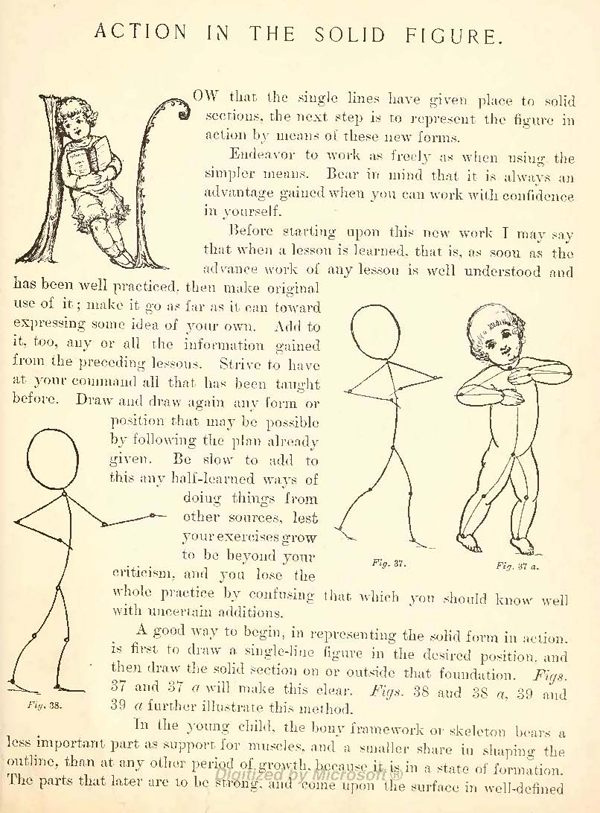Home > Directory of Drawing Lesson > Human Face > Figures in Motion > Actions by Means of Solid Figures
drawing children and KIDS in action & motion by means of SOLID FIGURES
|





[The above words are pictures of text, below is the actual text if you need to copy a paragraph or two]
ACTION IN THE SOLID FIGURE
Now that the single lines have given place to solid sections, the next step is to represent the figure in action by means of these new forms.
Endeavor to work as freely as when using the simpler means. Bear in mind that it is always an advantage gained when you can work with confidence in yourself.
Before starting upon this new work I may say that when a lesson is learned, that is, as soon as the advance work of any lesson is well understood and has been well practiced, then make original use of it ; make it go as far as it can toward expressing some idea of your own. Add to it, too, any or all the information gained from the preceding lessons. Strive to have at your command all that has been taught before. Draw and draw again any form or position that may be possible by following the plan already given. Be slow to add to this any half-learned ways of doing things from other sources, lest your exercises grow to be beyond your criticism, and you lose the whole practice by confusing that which you should know well with uncertain additions.
A good way to begin, in representing the solid form in action, is first to draw a single-line figure in the desired position. and then draw the solid section on or outside that foundation. Figs. 37 and 37 a will make this clear. Figs. 38 and 38 a, 39 and Fig. 38. 39 a further illustrate this method.
In the young child, the bony framework or skeleton bears a less important part as support for muscles, and a smaller share in shaping the outline, than at any other period of a state of formation.
The parts that later are to be , r ng, and come upon the surface in well-defined projections are undeveloped in the baby and concealed by the soft outer covering. This is especially true of the joints. The lack of growth in the frame and muscles is peculiar to the young child only. This is the one great reason why the baby form is so pliable, so easily bent in any position.
In Figs. 39 a and 39 b. notice that the abdominal or front line rolls out or doubles upon itself, and that the line of the back also is rounded. This is caused by the internal organs pressing against the side walls that hold them when the height of the cavity is shortened 1) y bending forward.
If any difficulty should be met when trying to draw the figure seated, it will be well to start with the side view. This is easiest for a beginner, because the proportions can easily be kept in sight, and 110 foreshortening be needed as in a front view.
Foreshortening is the apparent shortening of a line or object seen obliquely. or endwise. See Fius. 40 and 40 a.
The thing that makes the person look seated is the horizontal direction of the thighs, with the upright body.
It is something worth while to be able to seat the figure ; but, a.s comfort and ease are desirable, try also and make your children look as if they enjoyed the position. When a child reclines upon a couch, or the ground, it has stopped holding itself up and sinks down with relaxed muscles — the soft, pliable outline of- the body fitting that upon which it lies. If you will notice this and work to express it, rest and repose will be suggested (Fig. 41).
Draped figures come under the same rules as the nude or undraped. Whether the clothing be heavy or light, do not attempt to avoid difficulties by covering the form too much, so a.s to hide it. Somewhere the true proportions of the child should be revealed (Fig. 42). If you show only the head above a mass of clothing, without a hint of the form of what is below it, the head might as well be on a stick, and the whole be called a stand for drapery, so far a.s any idea or purpose is concerned. Every picture should express some thought or intention, and so give reason for its having been made.
There is a way of making artistic use of figure and drapery together, and that is. to let the folds so fall that the garment graces and adds to the beauty or significance of the figure.
As a rule to follow carefully, always choose positions in which some of the leading proportions of the figure are indicated by the lines of the drapery. Note„ for instance, through the covering, such valuable and characteristic markings as the position and breadth of the shoulders, the line of the body under the arm, the point of the knee, the location of heel, the length of the back, or the bend of the elbow — any view taken will give an opportunity to show some of these places.
Never lose sight of all the points of interest and expression which belong to the figure itself, for in all draped-figure drawings the character of the work demands that something of the wonderful construction of the human form be seen, or indicated.




